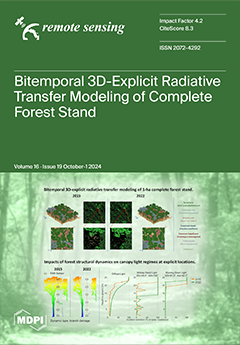Catch crops are intermediate crops sown between two main crop cycles. Their adoption into the cropping system has increased considerably in the last years due to its numerous benefits, in particular its potential in carbon fixation and preventing nitrogen leaching during winter. The
[...] Read more.
Catch crops are intermediate crops sown between two main crop cycles. Their adoption into the cropping system has increased considerably in the last years due to its numerous benefits, in particular its potential in carbon fixation and preventing nitrogen leaching during winter. The growth period of catch crops in Germany is often marked by dense cloud cover, which limits land surface monitoring through optical remote sensing. In such conditions, synthetic aperture radar (SAR) emerges as a viable option. Despite the known advantages of SAR, the understanding of temporal behavior of radar parameters in relation to catch crops remains largely unexplored. Hence, in this study, we exploited the dense time series of Sentinel-1 data within the Copernicus Space Component to study the temporal characteristics of catch crops over a test site in the center of Germany. Radar parameters such as VV, VH, VH/VV backscatter, dpRVI (dual-pol Radar Vegetation Index) and VV coherence were extracted, and temporal profiles were interpreted for catch crops and preceding main crops along with in situ, temperature, and precipitation data. Additionally, we examined the temporal profiles of winter main crops (winter oilseed rape and winter cereals), that are grown parallel to the catch crop growing cycle. Based on the analyzed temporal patterns, we defined 22 descriptive features from VV, VH, VH/VV and dpRVI, which are specific to catch crop identification. Then, we conducted a Kruskal–Wallis test on the extracted parameters, both crop-wise and group-wise, to assess the significance of statistical differences among different catch crop groups. Our results reveal that there exists a unique temporal pattern for catch crops compared to main crops, and each of these extracted parameters possess a different sensitivity to catch crops. Parameters VV and VH are sensitive to phenological stages and crop structure. On the other hand, VH/VV and dpRVI were found to be highly sensitive to crop biomass. Coherence can be used to detect the sowing and harvest events. The preceding main crop analysis reveals that winter wheat and winter barley are the two dominant main crops grown before catch crops. Moreover, winter main crops (winter oilseed rape, winter cereals) cultivated during the catch crop cycle can be distinguished by exploiting the observed sowing window differences. The extracted descriptive features provide information about sowing, harvest, vigor, biomass, and early/late die-off nature specific to catch crop types. In the Kruskal–Wallis test, the observed high H-statistic and low
p-value in several predictors indicates significant variability at 0.001 level. Furthermore, Dunn’s post hoc test among catch crop group pairs highlights the substantial differences between cold-sensitive and legume groups (
p < 0.001).
Full article





